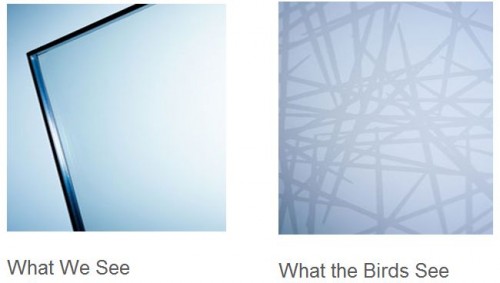A company in Germany (http://www.ornilux.de/C) announced recently that it has developed a cool new glass that incorporates an ultraviolet reflective (or absorptive? I can’t find a source that says for sure.) coating, which is invisible to humans but quite visible to birds. Birds, it seems, just don’t get regular glass. Either they interpret reflected surroundings as more trees and grass and parking lots, or they see right through the glass, blind to the barrier. Bonk!
According to a 2004 story in Audubon Magazine and a few other sources who all seem to quote ornithologist Daniel Klem of Muhlenberg College, in Pennsylvania, “Between 100 million and 1 billion birds die in glass collisions every year in North America alone.” Wow. 100 million to one billion birds? That’s nearly three birds a second on the low end, more than bird deaths due to vehicles, poisons and communications towers (says the internet). Although dead bird sightings in the doorway of my dreary but heavily glassed graduate building were common, I had no idea that death by window was such a phenomenon.
(I would like to add here that I am doing my part for the environment by keeping my home’s windows safe for birds via numerous greasy hand and dog prints. Welcome.)

Image via “Archetecturals” at http://www.architerials.com/2010/08/ornilux-mikado-glass-stops-birds-slamming-into-windows/
The frustrating thing about industry research compared to government-funded and university work, is that you can't just grab the paper from Google Scholar. Though likely copied from a press release, this Archetecturals quote contained the most comprehensive description of actual tests that I could find: “The glass was tested on 19 species of garden birds in a flight tunnel at the Radolfzell Bird Sanctuary. Wild birds were captured and released into the flight tunnel, where they could choose to fly towards a sheet of plain glass or a sheet of Ornilux glass. Of the 108 test flights, 82 of the birds flew towards the plain glass and avoided the Ornilux.”
Unlike decals (which apparently don’t work anyway) and frosted glass patterns, these windows preserve the view of human admirers because we can’t detect the UV wavelengths that the film reflects/absorbs.
What a great idea, right? Those German designers are so smart! Why, yes, I am sure they are, but sorry Bert, spiders have been using this same technology for years. It turns out that spiders likewise modulate the UV reflectivity/absorption of silk in their spider webs. Some sources report that by modulating the webs’ interactions with the UV spectrum, spiders help to prevent strikes by birds, and attract edible insect prey AT THE SAME TIME. Incredible!
But wait. Is that true? What about spider-eating birds? Spiders certainly wouldn’t want to leave out predator calling-cards. And shouldn’t bugs have evolved a solution to the spider trickery? A short dig through the literature reveals that scientists don’t know exactly how the UV modulation works. Most likely, they say, evolution has lead to many applications for UV-absorbing silk, which differs dramatically according to the spider and the spider’s environment. It also seems that spiders modulate patterns more quickly than the properties of the silk, which makes sense from an evolutionary standpoint since behavior modification should be easier.
One report in Biological Reviews 2000* notes, “A phylogenetic analysis of the different decoration patterns suggests that the different types of decorations are as evolutionary labile as the decorations themselves: the analysis shows little homology and numerous convergences and independent gains.”
In a later study published in Biology Letters**, researchers used spectrophotometric analysis (a measure of light's intensity as a function of frequency) to examine the webs of five spider species, and concluded, "Even though our data unambiguously demonstrate the visibility of web decorations to invertebrate and vertebrate models, the responses of receivers may be variable. For example, insect prey may be attracted the the chromatic contrast of the signal, especially its UV component. Alternatively, prey may detect the presence of the web via the visible web decorations and avoid capture. Moreover, birds may detect and avoid webs that contain web decorations, while birds that feed on the spider may actually locate their prey via web decorations."
Is it just me, or does this paragraph translate, "We really don't know how it works, but it seems pretty cool." ? Well, later reviews agree, and point out that we won't really understand these complex relationships until we better understand how spiders, birds and insects see. And here is where I say what so many seem not to understand: Basic research will always find an application.
* Biol Rev Camb Philos Soc. 2000 Nov;75(4):649-69.
** Biol Lett. 2005 September 22; 1(3): 299–302.
Published online 2005 May 24. doi: 10.1098/rsbl.2005.0307.




Comments